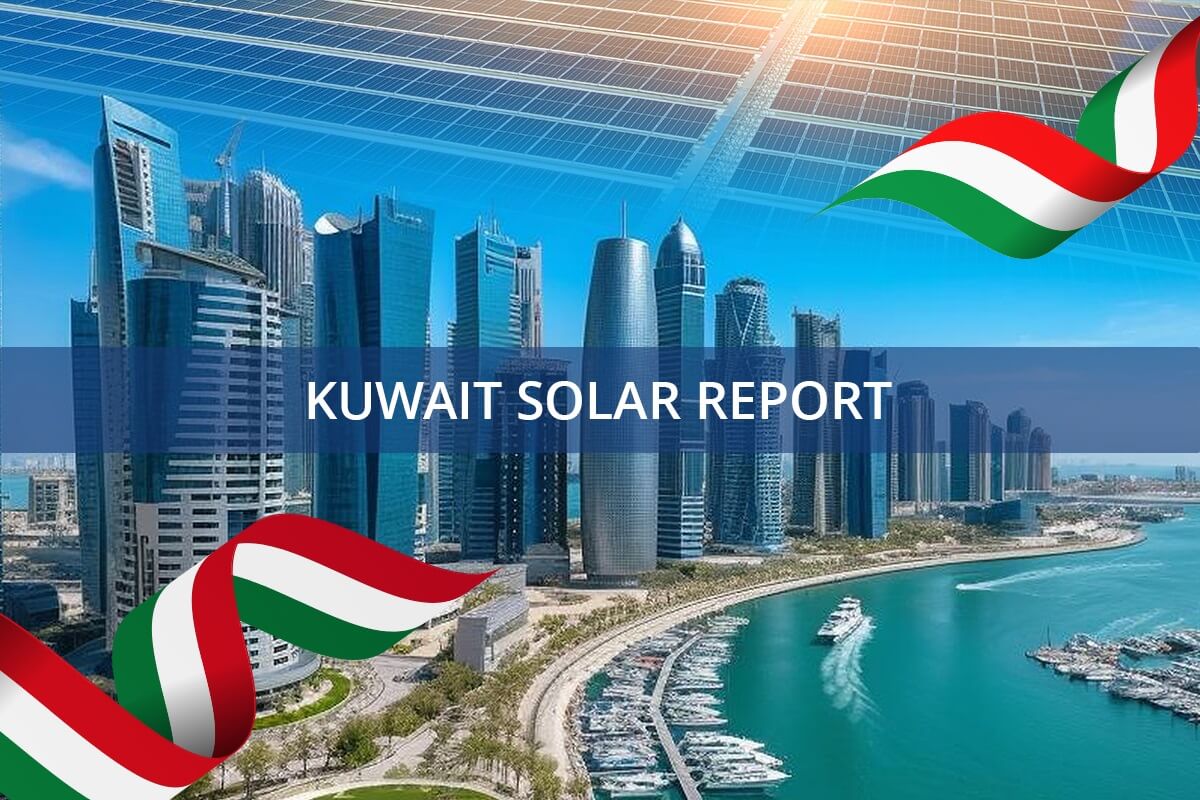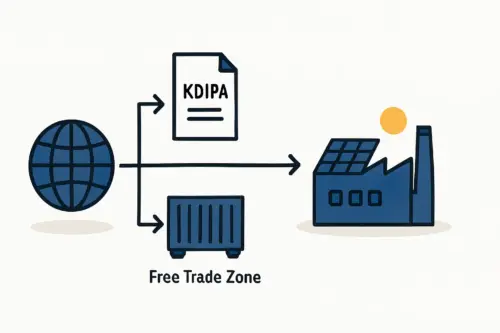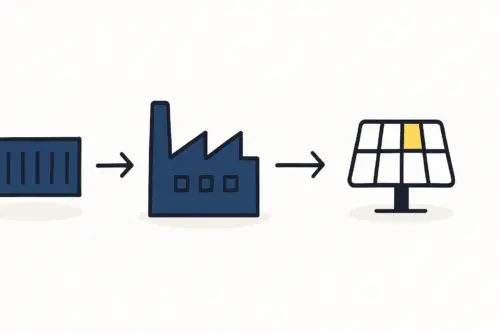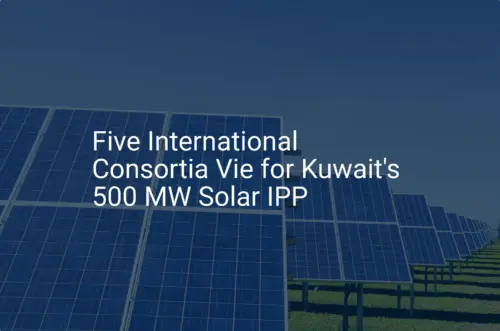A standard solar module, rated at 500 watts under ideal laboratory conditions, may only produce 400 watts or less during a typical summer afternoon in Kuwait. This significant drop in performance is not due to a fault in the module itself, but rather a mismatch between its design and the demanding local environment.
For entrepreneurs and investors considering solar manufacturing in the region, understanding this performance gap is the first step toward building a successful and sustainable business.
This guide explores the primary environmental challenges for solar modules in Kuwait—extreme heat and abrasive sand—and outlines the specific engineering and material science solutions needed to ensure long-term performance and durability.
The Twin Challenges: Extreme Heat and Abrasive Dust
The climate in Kuwait presents a formidable test for photovoltaic technology. Ambient temperatures regularly exceed 50°C, causing solar module surface temperatures to reach 75°C or higher. This heat is compounded by frequent sandstorms and the constant accumulation of fine dust, creating a uniquely harsh operating environment.
Understanding Thermal Stress and Power Loss
Every solar module has a ‘temperature coefficient,’ a technical value that defines how much its power output decreases for every degree Celsius above the standard test temperature of 25°C.
Standard modules, for instance, typically have a temperature coefficient between -0.35%/°C and -0.45%/°C. This means they lose about 0.4% of their power for every degree above 25°C. On an afternoon when a module’s cells reach 75°C—a 50°C increase—this translates into a power loss of 20% or more.
Advanced cell technologies, such as TOPCon or HJT, offer a significant advantage with superior temperature coefficients ranging from -0.24%/°C to -0.32%/°C. While this difference may seem small, it results in a substantially higher energy yield over the lifetime of a solar plant in a hot climate.
The Impact of Sand and Soiling on Performance
Beyond heat, airborne sand and dust pose two distinct threats:
-
Abrasion: During sandstorms, high-velocity sand particles can cause microscopic scratches and pitting on the module’s glass surface. Over time, this abrasion reduces the amount of light that can reach the solar cells, permanently degrading performance.
-
Soiling: This refers to the accumulation of dust and sand on the module surface, which blocks sunlight and reduces energy output. In desert regions like Kuwait, soiling can cause energy yield losses of 10% to 40% annually if not managed through frequent cleaning.
Ready to make big Profits?
The solar Industry is Booming
WE HELP NEWCOMERS to the solar industry start their own solar module production line. Customers can make BIG PROFITS by selling modules and finding investors, without wasting money and time on things they don't need!
Engineering Solutions for a Desert Environment
Addressing these challenges requires a deliberate approach to module design, focusing on material selection and structural integrity. A module built for the European market will simply not perform optimally or last as long in the Middle East.
Material Selection for Superior Durability and Heat Management
The foundation of a climate-resilient module lies in its components, with several key areas requiring adaptation:
-
Glass and Coatings: The front glass requires specialized coatings. An anti-reflective (AR) coating maximizes light absorption, while an anti-soiling coating creates a surface that resists dust adhesion. These coatings often have hydrophilic or hydrophobic properties that use morning dew or occasional rainfall to create a self-cleaning effect, reducing the need for frequent manual washing.
-
Encapsulants and Backsheets: The materials that seal and protect the solar cells are critical. In high-temperature, high-UV environments, Polyolefin Elastomer (POE) is often preferred over traditional EVA (Ethylene Vinyl Acetate) for its superior resistance to degradation. Likewise, UV-resistant backsheets are essential to prevent cracking and delamination.
-
Frames and Junction Boxes: The module frame can be designed to minimize dust buildup at the edges. The junction box, which houses the module’s electrical connections, must have a high Ingress Protection (IP) rating like IP68. This prevents the intrusion of fine dust and moisture, which can lead to electrical failures.
Design Principles for Long-Term Reliability
Beyond materials, the module’s overall construction plays a vital role. The solar panel manufacturing process must be adapted to incorporate these more robust designs.
-
Glass-Glass Construction: Using a sheet of glass for both the front and back of the module (a ‘glass-glass’ or bifacial design) offers several advantages. It provides enhanced mechanical strength and is less permeable to moisture and oxygen, slowing degradation. Glass is also a better heat conductor than a polymer backsheet, which can help slightly lower the module’s operating temperature.
-
Reinforced Frames: To withstand the mechanical stress of high winds and sandstorms, modules deployed in desert regions require a more robust and thicker aluminum frame.
The Business Case: Why Specialized Modules Matter
For a business professional, these technical details translate directly into financial outcomes. While a module designed for Kuwait’s climate may have a slightly higher upfront cost, it yields a significantly better return on investment over its 25- to 30-year lifespan.
The advantages are clear:
-
Higher Energy Yield: Better temperature performance and reduced soiling losses mean more kilowatt-hours generated per year.
-
Lower Operational Costs: Durable anti-soiling coatings reduce the need for frequent and costly cleaning cycles.
-
Increased Longevity: Robust materials and construction protect the investment from premature failure, ensuring reliable energy production for decades.
Establishing a local turnkey solar manufacturing line provides the strategic advantage of producing modules precisely engineered for these regional conditions, creating a product with a clear competitive edge over standard imported panels.
Frequently Asked Questions (FAQ)
What is a temperature coefficient and why is it important for Kuwait?
The temperature coefficient measures how much a solar panel’s power output drops as its temperature rises. A lower (less negative) coefficient is better. In Kuwait’s hot climate, where panels routinely operate at high temperatures, a module with a lower temperature coefficient will produce significantly more energy than one with a standard coefficient.
How significant are energy losses from dust in Kuwait?
Without regular cleaning, energy losses from dust and sand accumulation (soiling) can be substantial, often ranging from 10% to over 30% annually. This makes cleaning schedules and anti-soiling technologies critical components of any solar project’s financial model.
Does a special anti-soiling coating eliminate the need for cleaning?
No, but it significantly reduces the frequency. An anti-soiling coating makes it harder for dust to stick to the surface and allows natural elements like dew to help wash it away. This extends the time between required manual or robotic cleanings, lowering operational expenses.
Are climate-specific solar modules significantly more expensive?
While they have a moderately higher upfront cost due to advanced materials and coatings, this initial investment is usually recovered quickly through higher energy production and lower maintenance costs. This leads to a lower Levelized Cost of Energy (LCOE) and a better long-term financial return.
Conclusion and Next Steps
Successfully deploying solar energy in Kuwait requires moving beyond standard ‘off-the-shelf’ solutions. The region’s extreme heat and dust demand solar modules that are specifically engineered for resilience and high performance in harsh conditions.
By focusing on key technical specifications—such as a low temperature coefficient, advanced anti-soiling coatings, and durable materials like POE and glass-glass construction—entrepreneurs can ensure their projects deliver optimal output and long-term financial viability. This attention to detail is the hallmark of a successful solar venture in a demanding market.









